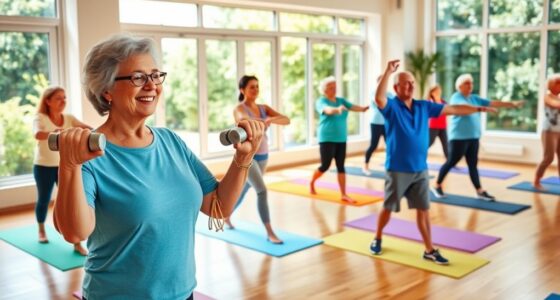Weight training is essential for you as you age, boosting strength, mobility, and overall well-being. It helps combat muscle loss, enhances daily function, and improves mental health. You can start with bodyweight exercises and gradually progress to weights, ensuring proper form to avoid injuries. Committing to regular sessions can keep you active and engaged. Plus, plenty of resources are available to support your journey toward a healthier life. There’s so much more to discover about starting this transformative practice.
Key Takeaways
- Strength training increases muscle mass and combats sarcopenia, enhancing overall physical function in elderly individuals.
- Regular weight training boosts bone density, reducing the risk of osteoporosis and fractures.
- Bodyweight exercises serve as a safe introduction to strength training, improving foundational strength before progressing to weights.
- Commitment to strength training improves mental health, reducing stress and symptoms of depression while boosting overall well-being.
- Utilize resources like SilverSneakers for access to guided workouts and community support, enhancing motivation and consistency.
Benefits of Strength Training for Seniors
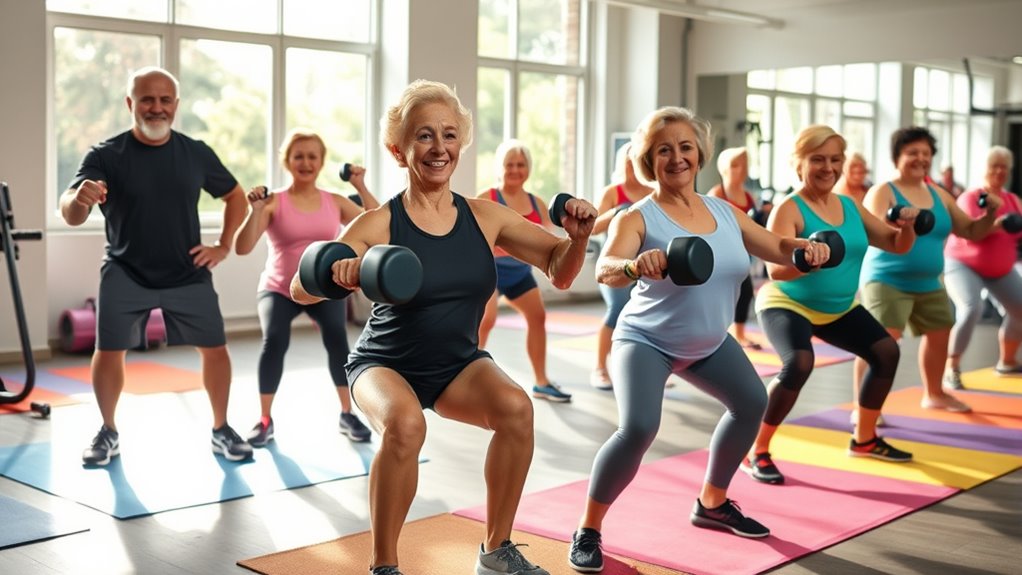
As you age, incorporating strength training into your routine can be a game changer for your health.
The benefits of strength training are numerous, especially for seniors. Regular strength training helps increase muscle mass, combating sarcopenia and enhancing your functional movements. You’ll find daily tasks like climbing stairs and lifting objects much easier and safer. Additionally, engaging in strength training can help protect energy by providing a structured routine that promotes stability. Moreover, it encourages the development of a growth mindset, which can be beneficial for overall mental well-being. Strength training can also create a supportive community, contributing to enhanced quality of life for seniors.
Furthermore, strength training greatly boosts bone density, reducing the risk of osteoporosis and fractures. It also aids in effective weight management by revving up your metabolism and reducing body fat.
Strength training enhances bone density, lowers osteoporosis risk, and supports weight management by boosting metabolism and decreasing body fat.
Beyond physical advantages, strength training promotes better mental health, alleviating symptoms of stress, anxiety, and depression. Additionally, engaging in physical activities like strength training can help foster playful communication among seniors, enhancing their social interactions and overall well-being.
Getting Started With Bodyweight Exercises
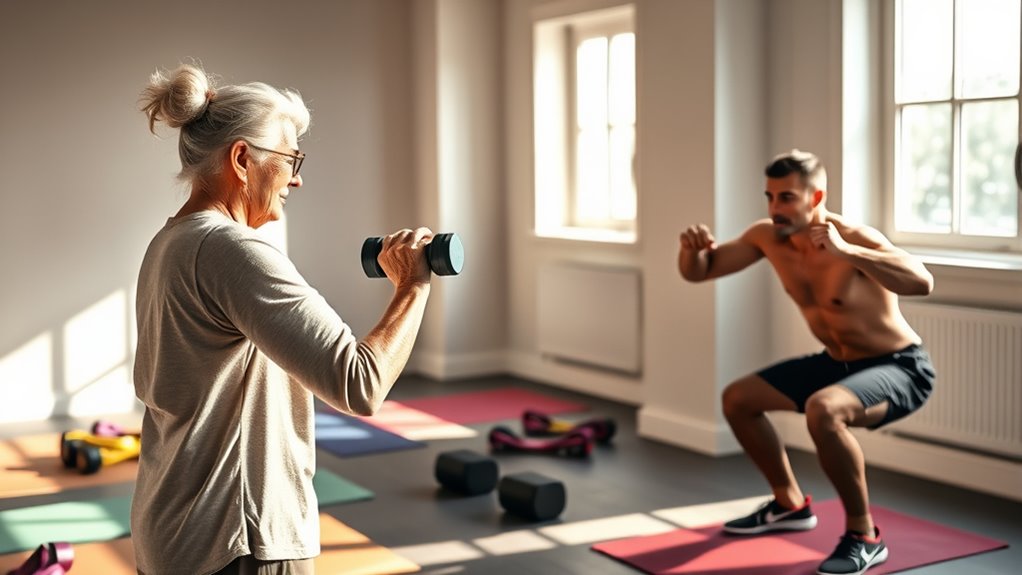
Bodyweight exercises are a great way for you to build strength and learn proper form before moving on to weights. Focusing on essential movements like pushups, squats, and lunges can help you engage your muscles safely and effectively. Incorporating essential oils like peppermint oil can also enhance your recovery by reducing muscle soreness. Additionally, using oils such as lavender oil can promote relaxation and improve sleep quality, which is beneficial for recovery. Understanding dementia medications is important for elderly individuals who may have health considerations while exercising. Once you feel comfortable, you can gradually progress to more challenging workouts. Additionally, adopting high vibrational energy can enhance your training routine by promoting gradual improvements and adaptability.
Benefits of Bodyweight Training
When you’re looking to start a fitness routine, bodyweight training offers a safe and effective way for older adults to build strength and improve control over their bodies. These exercises develop foundational strength without the injury risks associated with heavier weights. Focusing on proper form during bodyweight exercises helps prevent injuries and boosts confidence. Aim for three sets of 10 to 15 repetitions, training at least twice a week, while allowing for recovery time. As you progress, you can incorporate light weights for added challenge. Additionally, engaging in exercises that enhance mobility and balance can further support your overall health and well-being. Incorporating educational toys into your routine can also enhance cognitive function and mindfulness while exercising. It’s beneficial to consult pediatric sleep specialists for tailored advice on exercise routines that suit your individual needs. Regular physical activity is essential for elderly individuals, as it can reduce the risk of health issues and promote longevity. Including deterrent sprays designed to discourage unsafe movements can also enhance safety during workouts.
| Benefit | Description | Importance |
|---|---|---|
| Mobility | Enhances joint flexibility | Reduces fall risk |
| Balance | Improves stability during daily activities | Maintains independence |
| Strength | Builds foundational strength | Supports overall health |
Essential Bodyweight Exercises
Bodyweight exercises are perfect for older adults looking to build muscle strength and improve overall fitness without the risk of injury. It’s essential to maintain mental clarity as we age, as it supports our ability to perform physical activities effectively. Incorporating a balanced diet, including low-carb meal options, can further enhance your fitness journey. Additionally, focusing on high protein intake can aid in muscle repair and growth. Regular mammography screening is also important for older adults, as it helps in early detection of potential health issues.
Here are four essential exercises to include in your fitness routine:
- Squats – Great for leg strength and stability.
- Incline Pushups – Helps build upper body strength with less strain.
- Seated Rows – Excellent for improving posture and back strength.
- Dead Bug – Focuses on core stability; modify by keeping legs bent.
Aim for performing three sets of 10 to 15 repetitions for each exercise. As you grow stronger, gradually increase the weight or difficulty. Incorporating these exercises at least twice a week will boost your health and fitness considerably. Additionally, including educational toys in your routine can enhance coordination and motor skills, further promoting overall physical health.
Progressing to Weights
Building a solid foundation with bodyweight exercises sets you up perfectly to introduce weights into your routine. Start with basic strength training exercises like squats and pushups to establish proper form. Aim for three sets of 10 to 15 repetitions, allowing for gradual progression and growing confidence. Additionally, consider incorporating the soak method when watering any indoor plants you may have, as proper care for your environment can enhance your overall well-being. Regular socialization opportunities with others can also contribute to a positive mindset as you embark on your fitness journey. Furthermore, creating accessible living spaces can facilitate easier movement and engagement in physical activities, promoting a healthier lifestyle. Engaging in strong communication skills with your trainer can significantly enhance your understanding of proper techniques and progress.
Once bodyweight movements feel manageable, shift to light dumbbells or resistance bands for added challenge. Consulting a personal trainer can help guarantee you maintain proper form and address any health considerations. As your strength improves, gradually increase resistance while monitoring muscle soreness and recovery. This approach keeps your workouts safe and effective, paving the way for a stronger, healthier you. Additionally, ensure that your workout environment promotes proper airflow to enhance your overall comfort and performance during training.
Transitioning to Dumbbell Workouts

As you gain confidence and strength from bodyweight exercises, shifting to dumbbell workouts can enhance your fitness routine. This change helps build muscle and increase resistance training effectively. Here’s how to get started:
- Begin with light dumbbells that let you perform 8-12 repetitions comfortably, ensuring muscle fatigue without compromising form.
- Incorporate key exercises, like overhead presses and bent-over rows, targeting three sets of 12 repetitions with one to two minutes of rest between sets.
- Gradually increase the weight as your strength improves, always prioritizing control and avoiding pain.
- Aim for consistency by training two to three times a week, ensuring at least one full day of rest to promote recovery and overall muscle health. Color accuracy in your workout environment can also enhance your motivation and enjoyment during sessions.
Key Strength Exercises for Older Adults
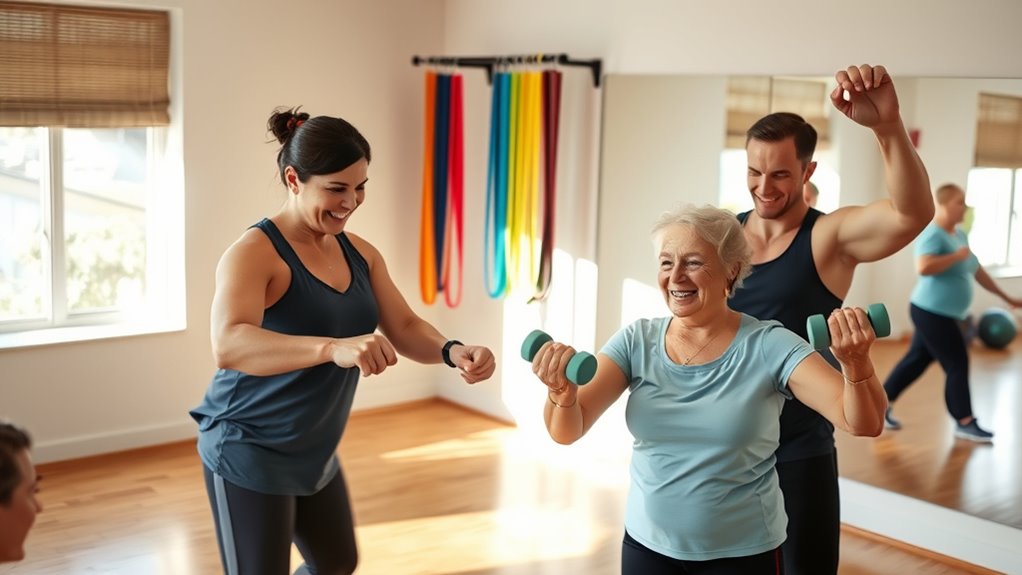
Shifting to dumbbell workouts lays the groundwork for incorporating key strength exercises that specifically benefit older adults.
Start with squats to enhance lower body strength and balance, essential for daily activities and fall prevention.
Incline pushups are great for building upper body strength, targeting your chest, shoulders, and triceps, with adjustable difficulty.
Incorporate seated rows using resistance bands to strengthen your back and improve posture, vital for maintaining mobility.
Don’t forget stationary lunges, which also boost lower body strength.
Finally, the dead bug exercise focuses on core stability and coordination, enhancing overall functional fitness and reducing injury risk.
Aim for 10 to 15 repetitions of each exercise to reap the maximum benefits.
The Importance of Regular Commitment

While the benefits of strength training for older adults are clear, committing to a regular workout schedule is essential for maximizing those advantages. Here’s why a regular commitment matters:
- Combat Muscle Loss: Engaging in strength training at least twice a week helps you build muscle and combat age-related decline.
- Adequate Recovery: Scheduling workouts on non-consecutive days allows for adequate recovery, reducing injury risk while promoting consistent gains.
- Improve Health: Regular sessions can help manage chronic conditions, improve your overall health, and elevate your fitness level.
- Enhance Mental Well-Being: A consistent routine can reduce stress and symptoms of depression, boosting your mental well-being.
Tips for Injury-Free Weight Training
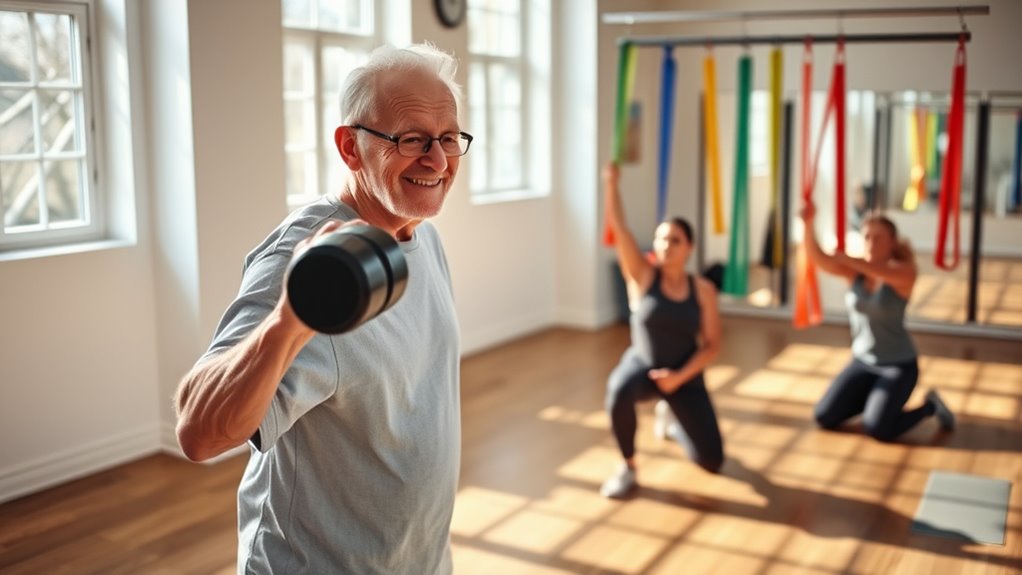
To guarantee a safe and effective weight training experience, it’s vital to prioritize injury prevention strategies.
Start your strength training with lighter weights, allowing you to complete 8-12 repetitions comfortably while maintaining proper technique. Avoid rushing through exercises or misaligning your body, as this can lead to injuries.
Expect some muscle soreness initially, but remember it should subside within a few days. If you experience pain, stop immediately and consider reducing the weights.
Hydration is important—drink plenty of water before, during, and after workouts to support muscle function.
Finally, incorporate rest days into your exercise program, allowing at least 24 hours between sessions for specific muscle groups.
Additional Resources and Support for Seniors
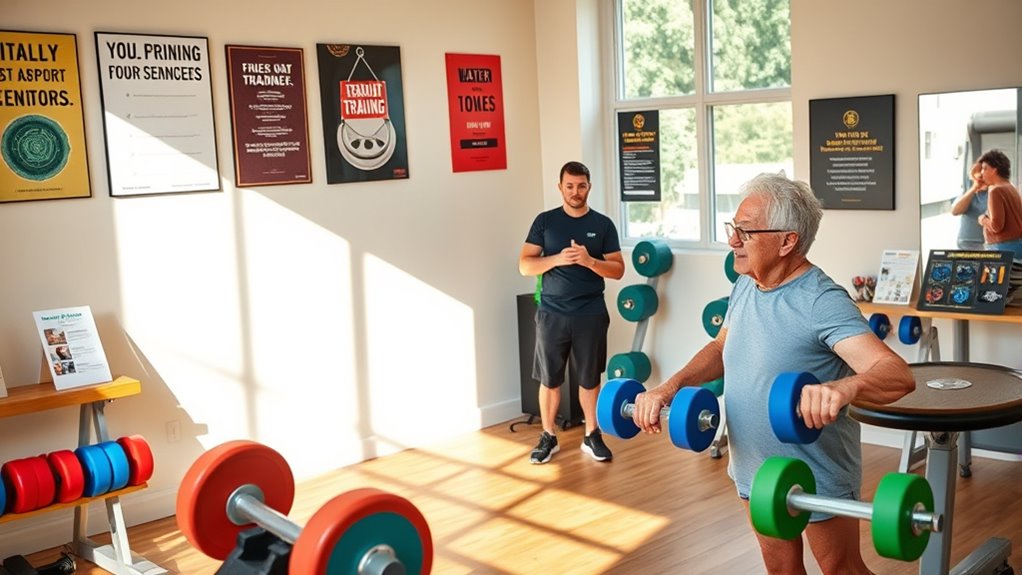
As you begin your weight training journey, various resources and support systems can enhance your experience and guarantee you stay motivated. Here are some valuable options:
- SilverSneakers Membership: Access hundreds of free on-demand workout videos and live fitness classes designed for seniors.
- Local Fitness Centers: Use your SilverSneakers member ID to find nearby gyms that offer tailored health and wellness resources.
- Group Fitness Classes: Engage socially while improving your strength training under certified instructors, ensuring you maintain proper form.
- Educational Materials: Take advantage of how-to video collections and guides on nutrition and exercise to boost your overall health and quality of life.
With these resources, your physical activity journey will be both enjoyable and effective.
Frequently Asked Questions
What Is the Best Weight Lifting Routine for Seniors?
To find the best weight lifting routine for seniors, aim for two to three sessions a week.
Focus on major muscle groups with exercises like squats, lunges, overhead presses, and rows. You should do 8-12 repetitions per exercise, resting for 1-2 minutes between sets.
Start with lighter weights or resistance bands to master your form, and always consult a healthcare provider to tailor the program to your individual health needs and guarantee safety.
Should a 70 Year Old Do Strength Training?
As the sun rises, illuminating the path ahead, you should absolutely embrace strength training at 70.
It’s not just about lifting weights; it’s about lifting your quality of life. Engaging in strength exercises can enhance your muscle mass, boost bone density, and promote overall mobility.
Can a 70 Year Old Regain Muscle Tone?
Yes, you can regain muscle tone at 70!
Engaging in consistent strength training, like resistance exercises, helps improve muscle mass and strength considerably. If you work out at least twice a week, you’ll likely notice positive changes in your muscle tone and overall physical function.
Start with bodyweight exercises, then gradually add light weights.
Don’t forget that proper nutrition, especially protein intake, plays a vital role in maximizing your results.
What Is the 6 12 25 Rule?
Did you know that incorporating varied repetition ranges can boost muscle growth by up to 25%?
The 6 12 25 Rule is a training method where you perform six reps of a heavier weight, followed by twelve reps of a moderate weight, and finish with twenty-five reps of a lighter weight.
This approach targets different muscle fibers, ensuring a well-rounded workout that enhances both strength and endurance while keeping things interesting!
Conclusion
Incorporating strength training into your routine can truly enhance your quality of life as you age. By starting with bodyweight exercises and gradually moving to dumbbells, you’ll build strength safely and effectively. Remember, consistency is key—so why not commit to a healthier, stronger you today? With the right precautions and resources, you can enjoy all the benefits of weight training while minimizing the risk of injury. Embrace this journey to a better life—you’re worth it!


